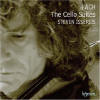Texte paru dans: / Appeared in:
*

Fanfare Magazine # 30:6 (07/08 - 2007)
Pour
s'abonner / Subscription information
Les abonnés à Fanfare Magazine ont accès aux archives du
magazine sur internet.
Subscribers to Fanfare Magazine have access to the archives of the magazine
on the net.
Hyperion
CDA 67541/2

Code-barres / Barcode:
0034571175416
The first four suites occupy the first CD. The immediacy of Henry Wood Hall in London is evident from the first bars of the Suite in G major. Isserlis produces a warm tone, richly founded; his phrasing is easeful and there is a palpable sense of dedication underlining each note; improvisation, flow, and focus are well balanced. The music’s particulars and long line are finely honed. The manner in which Isserlis has been presented is gratifying in its intimacy.
This is music that Isserlis seems to have lived with for many years. His playing has familiarity but not contempt (probably impossible to tire of this music, which must have boundless possibilities). Isserlis’s pointing is lively, his tempos anything but moribund; these are, after all, suites of dances; even the Sarabandes must have a sense of movement, which they do here but without sacrificing their eloquence. The opening of the Suite in D Minor (No. 2) is especially lovely: a searching beginning.
I have Casals’s recordings, and Starker’s, and have long appreciated the selfless dedication these musicians have brought to this fascinating music. Heinrich Schiff (EMI) was a revelation to me for really underlining the spirit of the dance that Bach took as his starting point, and it’s been interesting to hear Harnoncourt (long before he was conducting) tackle this music when a full-time cellist. Jian Wang (DG) is a very inviting host of this music, and Antonio Meneses (Avie) is an excellent guide.
Isserlis’s set is compelling for reasons sometimes difficult to say. Certainly he brings a sense of purposeful motion to each movement, but never rushing or lacking poise, and he has a just sense of scale that doesn’t reduce the spiritual dimension that Bach’s invention can have. Isserlis’s musical response is both natural and personal, his gift for transporting the listener considerable, and in those two suites that, for me, can be difficult to fathom—the last two—Isserlis finds an expression and a vitality (interpretatively and technically) that is often a revelation.
For the record, Isserlis plays Suite No. 6, written for a five-stringed instrument, on the conventional four strings. Five suites are played on a Stradivarius, leaving No. 5 to a Guadagnini. Isserlis’s booklet note explains his choices, and his five-page essay is comprehensive and illuminating (not least for his pictorial descriptions of each suite, which can be taken or left). Also included is The Song of the Birds, music closely associated with Pablo Casals, and here played, very affectingly, in an arrangement by Sally Beamish. Furthermore, there are three further versions of the Prelude to Suite No. 1, which are played from three different sources: Anna Magdalena (Bach’s wife), Peter Kellner (who probably produced the first copy of Bach’s cello suites—Bach’s original manuscript is lost), and Johann Christoph Westphal. All three have notational differences; Isserlis tends to favor Anna Magdalena as his source.
This Hyperion release is impressive and stimulating for the high production values, for the recording quality that offers a one-to-one between Bach and the listener, for Isserlis’s written annotation, and above all for his searching and intimate traversal of music that gets better and better the more one engages with it. Having spent much time listening to this issue and reading Isserlis’s insights, I can report that it has been time well spent: indeed, I seem to have moved closer to the music and all its enchanting mystery.
Cliquez l'un ou l'autre
bouton pour découvrir bien d'autres critiques de CD
Click either button for many other reviews


